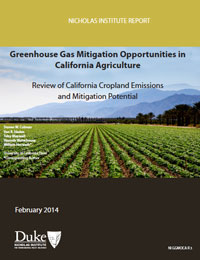Nicholas Institute for Environmental Policy Solutions
Publisher
Agriculture contributes approximately 7% of California’s total greenhouse gas (GHG) emissions; less than 3% of the state total comes from croplands. Efforts to reduce California’s agricultural GHG emissions from croplands will require sound information regarding how specific agricultural management practices impact those emissions over the landscape. A review of agricultural literature was conducted on studies that quantified GHG emissions in California annual and perennial croplands. This report reviews the available scientific literature relevant to GHG emissions from California croplands and quantitatively assesses the biophysical potential of various agricultural mitigation strategies relevant to California cropping systems. A total of 20 studies were identified, relating to 10 specific management practices in California croplands. Where possible, data from these studies were used to estimate the biophysical mitigation potential of various agricultural management practices. This work revealed that 3 of the 10 management practices—farmland preservation, expansion of perennial crops, and manipulation of nitrogen fertilizer rates—have high to medium relative mitigation potential. However, reliably estimating the biophysical mitigation potential of these practices is not possible at this time due to many uncertainties and lack of information. Relatively few field studies conducted in California rigorously examine GHG emissions from changes in agricultural management activities and practices. Thus, more research is needed to inform future management and policy alternatives.


